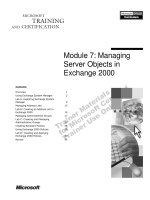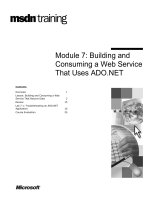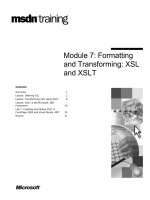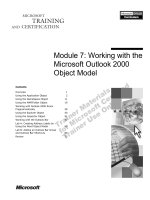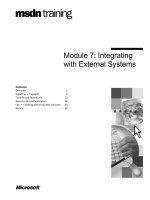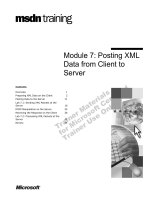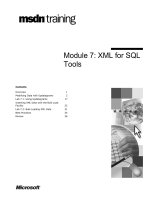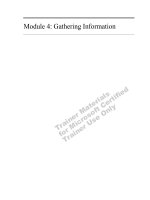Tài liệu Module 7: Presenting Information pptx
Bạn đang xem bản rút gọn của tài liệu. Xem và tải ngay bản đầy đủ của tài liệu tại đây (228.51 KB, 16 trang )
Module 7: Presenting Information
THIS PAGE LEFT INTENTIONALLY BLANK
Module 1: Course
Overview
Module 4: Gathering
Information
Module 5: Analyzing
Information: Use Cases
and Usage Scenarios
Module 6: Analyzing
Information: Rationalizing
Information
Module 7: Presenting
Information
Gathering and Analyzing
Business Requirements
Module 2: Identifying
Business Processes,
Challenges, and Vision
Module 3:
Characteristics of
Information
Summarizing and
Presenting the Results
Review
Module 7: Presenting
Information
Module 7: Presenting Information 157
!
!!
!
Overview
In this module...
In this module...
"
Summarizing and Presenting the Results
"
Review
After you have gathered and analyzed information on the business challenge,
you will need to present it in a format that communicates the results to users,
stakeholders, and the development team. A vision document represents one way
to present the results of the project team’s work.
In this module, you will use the vision document to summarize the information
that you have developed for the Ferguson and Bardell, Inc. case study. You will
also use the vision document as a way to review the concepts and skills that you
have learned in this course.
After completing this module, you will be able to:
"
Identify the contents and purpose of a vision document.
"
Develop a preliminary vision document.
"
Summarize the major concepts of the course.
Slide Objective
To provide an overview of
the module topics and
objectives.
158 Module 7: Presenting Information
!
!!
!
Summarizing and Presenting the Results
"
Envisioning Phase
"
Vision Document
"
Solution Concept
"
User Profiles
"
Business Goals
"
Design Goals
"
Activity 7.1: Developing a Preliminary
Vision Document
In this section...
In this section...
Throughout this course, you have been learning and performing tasks that are
part of the Envisioning Phase of the Microsoft
®
Solutions Framework (MSF)
Process Model. The activities that you have completed provide information for
the vision document, which is one of the main deliverables of the Envisioning
Phase.
In this section, you will review the main purpose of the Envisioning Phase.
Then you will review the items that make up the vision document. Finally, you
will learn about the items of the vision document that you have not discussed in
previous modules.
In Activity 7.1, you will develop a preliminary vision document for the
Ferguson and Bardell, Inc. case study.
Slide Objective
To provide an overview of
the section topics and
activity.
Module 7: Presenting Information 159
Envisioning Phase
"
Creates a high-level view of the project’s goals and
constraints
"
Serves as an early form of planning
"
Helps the team pull different perspectives into a
common understanding
"
Provides the basis for future planning
"
Captures what the customer and key stakeholders deem
essential for success
The purpose of envisioning, which is the first of four phases in the MSF
Process Model, is to obtain an early understanding of the project’s goals and
constraints. The project team uses envisioning to answer feasibility questions,
gain approval from key stakeholders, and acquire a common set of expectations
from everyone involved. Envisioning is fundamental to the success of a project
because it sets the base upon which team members will build a shared vision.
Envisioning culminates in the Vision Approved Milestone. The outcome of
envisioning sets the stage for the more detailed planning effort that will come
later.
Approval of the project vision signals that members of the project team, the
customer, and key project stakeholders agree at a high level on why the project
is being done, what should be done, the risks of doing it, and who should do it.
The deliverables for the Vision Approved Milestone are the vision document,
the risk assessment document, and the project structure document. In this
course, you develop most of the information needed for the vision document.
Slide Objective
To summarize the
Envisioning Phase and how
it relates to the course.
Lead-in
The purpose of the
Envisioning Phase is to
obtain an early
understanding of the
project’s goals and
constraints.
Delivery Tip
Emphasize to students that
they do not complete the
Envisioning Phase in this
course. They develop most
of the information needed
for the vision document.
However, they do not take
the final step of optimizing
the information that they
have gathered, which is
necessary to complete the
vision document.
160 Module 7: Presenting Information
Vision Document
Content Purpose
Problem statement
Vision statement
Solution concept
User profiles
Business goals
Design goals
Why you want to do it
What you want the product to be
What you will do
Who will use the product
What you want to accomplish
How you plan to accomplish it
The vision document explicitly states the output of the envisioning process and
forms the basis of the first agreement among everyone involved in the project.
The vision document is the primary deliverable for the Vision Approved
Milestone. The project team uses it as the basis for deciding whether to go
ahead with the project. The vision document also provides a framework for
planning throughout the rest of the project.
The vision document should clearly explain why the team wants to do the
project, what the product will be and do, what the product will not be and do,
how the team will successfully complete the project, and what risks the team
will incur by taking on the project.
The items presented in this section represent those items that should be in the
document at a minimum. Additional items may be necessary, such as an issues
section that lists risks that the team cannot mitigate without outside
intervention. The nature of the business and project will ultimately determine
what the project team will include in the vision document.
In this module, you will focus on developing a preliminary vision document to
communicate project information to stakeholders. You can communicate a
shared vision through other ways, such as presentations to stakeholder groups,
Web sites, or company newsletters.
You have already developed the problem statement, or business challenge, and
the vision statement earlier in this course. The remainder of this section covers
the new items that you need to develop. The information that you have gathered
and analyzed throughout the course will help you to develop the additional
items.
Slide Objective
To summarize the purpose
and parts of a vision
document.
Lead-in
The vision document
explicitly states the output of
the envisioning process.
